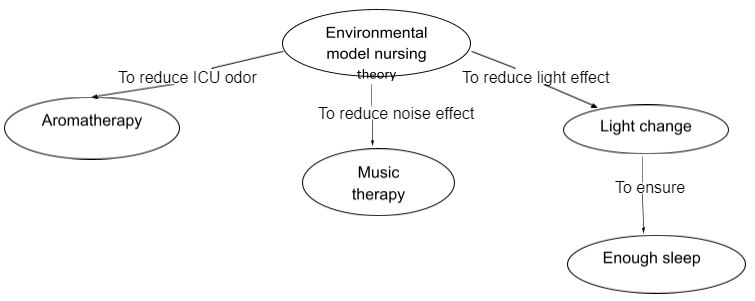Nurse practitioners are majorly concerned with ensuring that there is proper implementation and a rendering of helpful and professional nursing care. This requires the application of various nursing practice theories depending on the level of care the patient needs. Florence Nightngale’s theories of nursing help nurses to plan and deliver effective and efficient care services for the well-being of hospitalized patients. This essay provides a case scenario where Florence Nightingale’s environmental model nursing theory was used during a hospitalized patient-nursing interactions. It also provides a concept map that summarizes the scenario.
Hospitalized Case Scenario
Hospitalized patients interact with nurse practitioners frequently as they receive nursing care. Therefore, it is the responsibility of a nurse to ensure that the environment in which patients stay is conducive enough so that the natural laws would allow healing to take place. Hospitalized patients with various diseases require a nurse to apply various nursing theories to provide effective and efficient nursing care. The case scenario discussed in this essay is a 57-year-old male who was admitted at the postoperative care unit. The patient had undergone a four-vessel bypass and was placed in a 2-bed ICU bay.
On the first day after the operation, he appeared worried during the day. However, after orientation, he became cooperative with care. However, at night he appeared restless, and stated that he was uncomfortable with the unfamiliar new environment and the weird noises of the eventful unit. On the second postoperative day, the patient’s pain was difficult to control all over the night. This added to his disturbance and anxiety.
A careful analysis of the patient revealed that he had problems with pain, anxiety, change in lighting due to increased activity overnight, loud noises, and bad odors in the ICU unit. To facilitate his care and healing, the environmental model nursing theory was applied. The patient was moved to a place where he would access enough natural light during the day. At night, the patient’s bed light was reduced to facilitate his sleep. This also ensured maximum reduction of the offensive light due increased activity overnight. Loud noises in the ICU interfered with his restful sleep at night, adding to his agitation.
Therefore, a quiet environment was required to ensure that he sleeps enough to manage his persistent pain at night. The patient was shifted to a bed near the corner where movements were minimal and the noises were low. In addition, music therapy was applied to the patient whereby he was allowed to listen to Christian music since he confirmed that he was a Christian, and he liked listening to such music. Furthermore, the ICU odors affected the patient’s well-being. They facilitated his anxiety and agitation. To address this problem, a sweet smelling perfume was applied every morning in the unit to kill the odors. After all the above nursing care measures were applied the patient’s complaints reduced drastically. After a few days, he was discharged from the ICU. Quicker healing is attributed to the environment the patient was placed in that allowed natural laws to facilitate healing.
Concept Map
The figure below is a concept map for the case scenario described in the essay above

